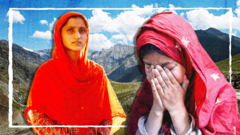The ongoing conflict in Kashmir has reached a critical point as violence escalated into a series of deadly exchanges between India and Pakistan. Civilians on both sides have suffered greatly, showcasing the fragility of peace and the urgent need for diplomatic intervention.
A Fragile Peace: India and Pakistan on the Edge of Conflict

A Fragile Peace: India and Pakistan on the Edge of Conflict
Recent escalations between India and Pakistan have led to deadly attacks along the Line of Control, raising the risk of full-blown war between the nuclear-armed neighbors.
In the latest horrific chapter of the decades-long conflict over Kashmir, fresh violence between India and Pakistan has left scores dead, as both nations engage in fierce military strikes that threaten to escalate into a larger war. Sixteen-year-old Nimra stood in shock as India’s missiles struck a mosque close to her home in Pakistan-administered Kashmir, unknowingly injured as shrapnel lodged itself near her heart. Meanwhile, in Indian-administered Kashmir, the tragedy continued as Indian shelling prompted chaos, resulting in the death of 13-year-old Vihaan and horrified witnesses scrambling for safety.
The clashes were ignited following a militant attack in April that left 26 mostly Indian tourists dead, prompting a retaliatory missile strike from India targeting what it claimed were militant camps across the border. Pakistan has cast doubt on these claims, demanding evidence and an independent inquiry. For four days, the two nations engaged in a flurry of retaliatory fire, missile strikes, and drone attacks, marking some of the deadliest violence the region has seen in recent years.
Diplomatic communications between both nations intensified amid the chaos, with Pakistani officials revealing they were prepared for the heightened military action and signaling readiness to respond decisively to any Indian incursion. Yet, for ordinary civilians caught in the crossfire, the lack of timely warnings and evacuations meant that scores suffered without notice, leaving neighborhoods devastated and families shattered.
Further complicating matters, the international community has watched with apprehension as tensions mounted. The U.S. played a key role in mediating a ceasefire, but the Indian government later downplayed this involvement, insisting that military action was necessary for national security. With incidents like the tragic loss of relatives and homes in Uttarakhand now painting a grim picture, families on both sides decry the violence and the lack of accountability for their suffering.
In the wake of the ceasefire announced on May 10, the grim toll of the violence remains, with both sides left to pick up the pieces from a conflict that exposed the precarious nature of peaceful coexistence in the region. As communities grieve and rebuild, there is a palpable call for lasting dialogue and resolution to prevent future bloodshed, highlighting the urgent need for a sustainable peace strategy between these two nuclear powers. The scars of this recent violence serve as a sobering reminder of the fragility of peace in Kashmir, where hope for a brighter future often seems to be overshadowed by the specter of conflict.
The clashes were ignited following a militant attack in April that left 26 mostly Indian tourists dead, prompting a retaliatory missile strike from India targeting what it claimed were militant camps across the border. Pakistan has cast doubt on these claims, demanding evidence and an independent inquiry. For four days, the two nations engaged in a flurry of retaliatory fire, missile strikes, and drone attacks, marking some of the deadliest violence the region has seen in recent years.
Diplomatic communications between both nations intensified amid the chaos, with Pakistani officials revealing they were prepared for the heightened military action and signaling readiness to respond decisively to any Indian incursion. Yet, for ordinary civilians caught in the crossfire, the lack of timely warnings and evacuations meant that scores suffered without notice, leaving neighborhoods devastated and families shattered.
Further complicating matters, the international community has watched with apprehension as tensions mounted. The U.S. played a key role in mediating a ceasefire, but the Indian government later downplayed this involvement, insisting that military action was necessary for national security. With incidents like the tragic loss of relatives and homes in Uttarakhand now painting a grim picture, families on both sides decry the violence and the lack of accountability for their suffering.
In the wake of the ceasefire announced on May 10, the grim toll of the violence remains, with both sides left to pick up the pieces from a conflict that exposed the precarious nature of peaceful coexistence in the region. As communities grieve and rebuild, there is a palpable call for lasting dialogue and resolution to prevent future bloodshed, highlighting the urgent need for a sustainable peace strategy between these two nuclear powers. The scars of this recent violence serve as a sobering reminder of the fragility of peace in Kashmir, where hope for a brighter future often seems to be overshadowed by the specter of conflict.





















